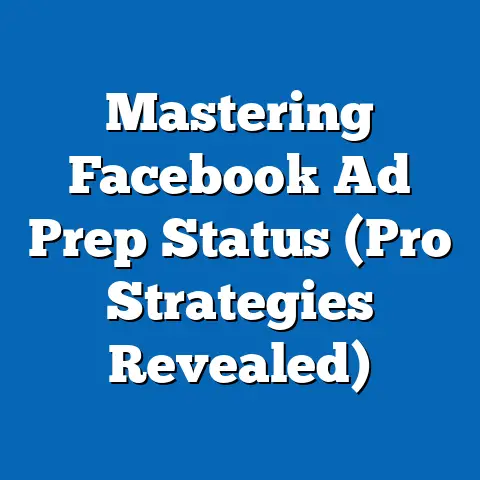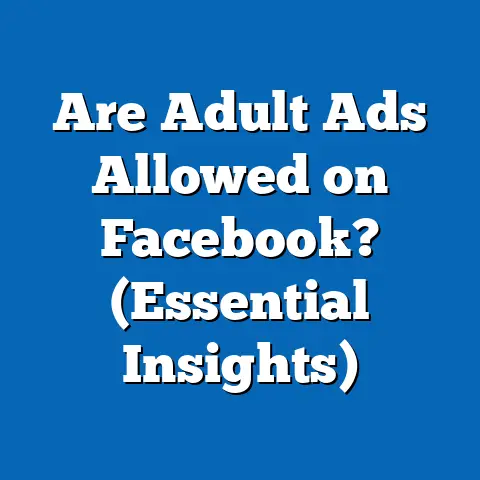Congress Unveils 3,000+ Russian Facebook Ads (Insightful Reveal)
Imagine peeling back the layers of an onion. Each layer reveals another, and the deeper you go, the more complex and pungent the experience becomes. The unveiling of over 3,000 Russian Facebook ads by Congress is much the same. It’s not just a single event; it’s a complex layering of narratives, strategies, and implications that unfold in the realm of social media advertising and political discourse. For me, this moment was a stark reminder of the power, and potential peril, of social media platforms in shaping public opinion and influencing democratic processes.
I remember back in 2016, working on social media campaigns for local businesses. We were hyper-focused on A/B testing ad copy, optimizing targeting, and driving conversions. The idea that foreign entities were using the same platform to sow discord and influence an election felt like something out of a spy novel. But it was real, and the release of these ads by Congress shed a harsh light on the scale and sophistication of the operation.
This article will delve into the significance of these ads in the context of the 2016 U.S. Presidential election and the ongoing conversation about foreign interference in democratic processes. We’ll explore the content of the ads, the targeting mechanisms used, the congressional response, and the broader implications for trust in media.
1. Contextualizing the Unveiling
A Brief History of the Investigation
The story of Russian interference in the 2016 U.S. Presidential election didn’t begin with the unveiling of Facebook ads. It was a slow burn, a series of investigations and reports that gradually revealed the extent of the operation. Key milestones include:
- Early 2016: Initial reports of Russian hacking into the Democratic National Committee (DNC).
- October 2016: The U.S. intelligence community formally accused Russia of interfering in the election.
- January 2017: The release of the Intelligence Community Assessment (ICA) detailing Russia’s efforts to influence the election.
- May 2017: Robert Mueller was appointed as Special Counsel to investigate Russian interference.
It was within this context that investigations into social media platforms, particularly Facebook, began to intensify. The focus shifted to how these platforms were being used to spread propaganda and misinformation.
The Power of Social Media in Shaping Public Opinion
Social media has fundamentally altered the way we consume information and engage with the world. It’s a powerful tool for connecting with others, sharing ideas, and organizing movements. But it’s also a double-edged sword. The very features that make social media so engaging – its reach, its speed, its ability to target specific audiences – also make it vulnerable to manipulation.
Facebook, with its billions of users, is arguably the most influential social media platform in the world. It’s where people get their news, connect with friends and family, and discover new products and services. It’s also a prime target for those seeking to influence public opinion.
According to Pew Research Center, a significant portion of Americans get their news from social media. This reliance on social platforms for information makes them a powerful battleground for shaping narratives and influencing voter behavior.
The Timeline of Discovery and Exposure
- Early 2017: Facebook began investigating suspicious activity on its platform.
- September 2017: Facebook announced that it had identified over 3,000 ads linked to a Russian entity called the Internet Research Agency (IRA).
- October 2017: Facebook provided the ads to Congress.
- November 2017: Congress released the ads to the public.
The release of these ads was a watershed moment. It provided concrete evidence of the Russian government’s efforts to interfere in the U.S. election. I remember the feeling of disbelief and anger as I scrolled through the ads, seeing how easily people could be manipulated by sophisticated propaganda campaigns.
Takeaway: The unveiling of the Russian Facebook ads was the culmination of a long investigation into foreign interference in U.S. elections. It highlighted the power of social media platforms to shape public opinion and the need for greater transparency and accountability.
2. Analyzing the Content of the Ads
Themes and Messages: Divisive Political Issues and Misinformation
The 3,000+ Russian Facebook ads weren’t a monolithic block of propaganda. They were diverse, sophisticated, and carefully crafted to exploit existing divisions within American society. The ads can be broadly categorized into several themes:
- Divisive Political Issues: These ads focused on hot-button issues like immigration, gun control, and racial tensions. They often amplified extreme viewpoints and sought to polarize public opinion.
- Social Justice Movements: Some ads pretended to support social justice movements like Black Lives Matter, while others sought to undermine them. The goal was to sow discord and create chaos.
- Misinformation Campaigns: These ads spread false or misleading information about political candidates, events, and issues. They aimed to confuse voters and undermine trust in legitimate news sources.
One particularly insidious tactic was to create fake news articles that looked like they came from legitimate news organizations. These articles were then shared widely on Facebook, often targeting specific demographics.
Language and Imagery: Provoking Emotional Responses
The language and imagery used in the ads were carefully chosen to provoke emotional responses from viewers. The ads often used:
- Strong emotional language: Words like “outrage,” “betrayal,” and “fear” were common.
- Visually striking images: Images of violence, protests, and political figures were used to grab attention and evoke strong feelings.
- Memes and viral content: The ads often incorporated popular memes and viral content to make them more relatable and shareable.
The goal was to bypass rational thought and appeal directly to people’s emotions. By tapping into pre-existing anxieties and prejudices, the ads were able to influence people’s perceptions and behaviors.
Notable Examples and Their Impact
One notable example was an ad that purported to support Black Lives Matter but actually promoted a protest against the movement. The ad used inflammatory language and imagery to stoke racial tensions and undermine the credibility of the movement.
Another example was an ad that spread false information about Hillary Clinton’s health. The ad claimed that Clinton was suffering from a serious illness and was unfit to be president. This misinformation was amplified by right-wing media outlets and spread rapidly online.
The impact of these ads is difficult to quantify precisely, but there’s little doubt that they played a role in shaping public opinion during the 2016 election. By exploiting existing divisions and spreading misinformation, they contributed to a climate of distrust and polarization.
Takeaway: The Russian Facebook ads were carefully crafted to exploit existing divisions within American society and spread misinformation. They used strong emotional language and visually striking images to provoke emotional responses from viewers and influence their perceptions and behaviors.
3. The Mechanisms of Targeting and Reach
Advertising Technology and Facebook’s Algorithms
Facebook’s advertising platform is incredibly sophisticated. It allows advertisers to target specific demographics, interests, and behaviors with laser-like precision. This is made possible by Facebook’s algorithms, which analyze vast amounts of data to predict what users are likely to be interested in.
Russian operatives were able to use Facebook’s advertising technology to target American audiences with remarkable accuracy. They were able to identify specific voter blocs and tailor their messages to appeal to their particular concerns.
For example, they could target conservative voters with ads that emphasized traditional values and warned against the dangers of liberalism. Or they could target liberal voters with ads that promoted social justice and criticized Donald Trump.
Data Analytics and Voter Blocs
The use of data analytics was crucial to the success of the Russian Facebook ads campaign. By analyzing data on voter demographics, interests, and behaviors, the IRA was able to identify specific voter blocs that were most susceptible to their messages.
Political marketing experts have noted that the IRA was particularly effective at targeting swing voters – those who were undecided or likely to vote for a third-party candidate. By swaying just a small percentage of these voters, the IRA could have a significant impact on the outcome of the election.
Privacy, Data Ethics, and Platform Responsibilities
The Russian Facebook ads campaign raised serious questions about privacy, data ethics, and the responsibilities of social media platforms. Facebook collects vast amounts of data on its users, and this data can be used to target them with advertising in ways that are both effective and potentially manipulative.
The campaign highlighted the need for greater transparency and accountability in political advertising. It also raised questions about whether social media platforms should be held liable for the content that is shared on their platforms.
I believe that social media platforms have a responsibility to protect their users from manipulation and misinformation. This includes taking steps to prevent foreign interference in elections and ensuring that political advertising is transparent and accountable.
Takeaway: The Russian Facebook ads campaign demonstrated the power of advertising technology and data analytics to target specific audiences with remarkable accuracy. It raised serious questions about privacy, data ethics, and the responsibilities of social media platforms in monitoring and regulating political advertising.
4. Congressional Response and Policy Implications
Reactions From Congress and Governmental Bodies
The unveiling of the Russian Facebook ads sparked outrage in Congress and other governmental bodies. Lawmakers from both parties condemned the Russian government’s efforts to interfere in the U.S. election and called for action to prevent future interference.
Several congressional committees launched investigations into the matter, and numerous hearings were held to examine the role of social media platforms in the spread of misinformation.
The Department of Justice also launched a criminal investigation into Russian interference, which resulted in indictments against several individuals and entities.
Legislative Measures and Advertising Transparency
In response to the Russian Facebook ads campaign, Congress introduced several legislative measures aimed at increasing advertising transparency and regulating social media platforms.
One notable example is the Honest Ads Act, which would require online political advertisements to disclose their funders and sources of origin. The bill has bipartisan support but has yet to be passed into law.
Other legislative proposals include measures to regulate the use of bots and fake accounts on social media platforms and to increase funding for cybersecurity and election security.
Freedom of Speech vs. Accountability
The debate over how to regulate political advertising on social media platforms has been complicated by concerns about freedom of speech. Some argue that any attempt to regulate political advertising would violate the First Amendment.
Others argue that the need to protect democratic processes outweighs the concerns about freedom of speech. They argue that social media platforms have a responsibility to ensure that political advertising is transparent and accountable, even if it means restricting certain types of content.
I believe that a balance can be struck between freedom of speech and the need for accountability. Social media platforms can implement reasonable regulations to prevent the spread of misinformation and foreign interference without unduly restricting legitimate political expression.
Takeaway: The unveiling of the Russian Facebook ads sparked a strong reaction from Congress and other governmental bodies, leading to legislative proposals aimed at increasing advertising transparency and regulating social media platforms. The debate over how to regulate political advertising has been complicated by concerns about freedom of speech, but a balance can be struck between freedom of expression and the need for accountability.
5. The Larger Conversation on Misinformation and Trust in Media
Impact on Public Trust in Media and Democratic Institutions
The Russian Facebook ads campaign had a significant impact on public trust in media and democratic institutions. The revelation that a foreign government had used social media to spread misinformation and sow discord eroded public confidence in the integrity of information sources.
According to a Gallup poll, trust in the media is at an all-time low. Only a minority of Americans say they have a great deal or fair amount of trust in newspapers, television, and radio.
This decline in trust has made it more difficult for legitimate news organizations to combat the spread of misinformation. It has also made it easier for foreign actors to manipulate public opinion.
The Role of Fact-Checking Organizations and Media Literacy
Fact-checking organizations and media literacy initiatives play a crucial role in combating the effects of misinformation. Fact-checkers work to verify the accuracy of claims made by politicians, news organizations, and social media users. Media literacy initiatives teach people how to critically evaluate information and identify fake news.
These efforts are essential to restoring public trust in media and democratic institutions. By providing people with the tools they need to distinguish between fact and fiction, we can help them resist the influence of misinformation campaigns.
Long-Term Consequences for Future Elections
The Russian Facebook ads campaign has had a lasting impact on the way we think about elections. It has made us more aware of the potential for foreign interference and the need for greater vigilance in protecting our democratic processes.
The long-term consequences of the campaign are still unfolding, but it’s clear that it has changed the political landscape in a fundamental way. Future elections will likely be characterized by increased scrutiny of social media platforms and greater efforts to combat the spread of misinformation.
Takeaway: The Russian Facebook ads campaign has had a significant impact on public trust in media and democratic institutions. Fact-checking organizations and media literacy initiatives play a crucial role in combating the effects of misinformation. The long-term consequences of the campaign are still unfolding, but it’s clear that it has changed the political landscape in a fundamental way.
Conclusion: Reflecting on the Layers of Influence
The Congress’s unveiling of the 3,000+ Russian Facebook ads was more than just a news event; it was a revelation of the intricate layers of influence that social media advertising can have on political discourse. The ads were designed to exploit existing divisions, spread misinformation, and undermine trust in democratic institutions.
The campaign highlighted the need for continued vigilance, transparency, and education to safeguard democratic processes in an increasingly digital world. Social media platforms must take greater responsibility for the content that is shared on their platforms, and governments must enact legislation to increase advertising transparency and regulate the use of bots and fake accounts.
But perhaps the most important lesson of the Russian Facebook ads campaign is the need for media literacy. We must teach people how to critically evaluate information and identify fake news. Only by empowering citizens with the tools they need to resist manipulation can we protect our democracy from foreign interference.
For me, the experience served as a harsh lesson in the power of digital advertising and the importance of ethical marketing practices. It reinforced the need to be vigilant, to question everything, and to prioritize truth and accuracy in all our communications. The future of democracy may depend on it.






